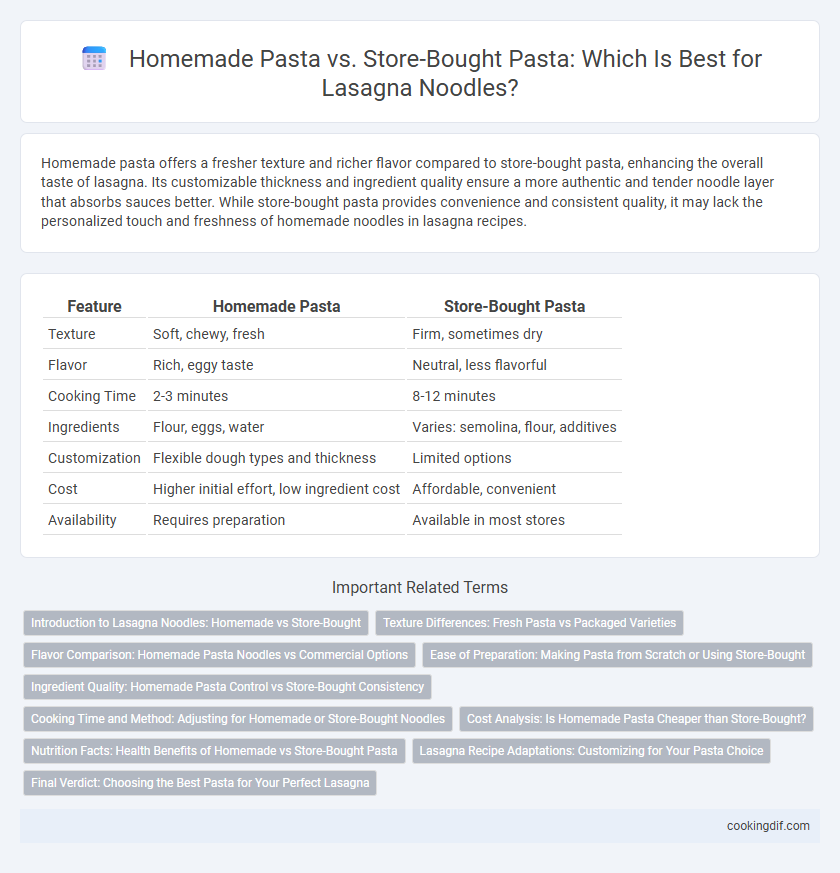Homemade pasta offers a fresher texture and richer flavor compared to store-bought pasta, enhancing the overall taste of lasagna. Its customizable thickness and ingredient quality ensure a more authentic and tender noodle layer that absorbs sauces better. While store-bought pasta provides convenience and consistent quality, it may lack the personalized touch and freshness of homemade noodles in lasagna recipes.
Table of Comparison
| Feature | Homemade Pasta | Store-Bought Pasta |
|---|---|---|
| Texture | Soft, chewy, fresh | Firm, sometimes dry |
| Flavor | Rich, eggy taste | Neutral, less flavorful |
| Cooking Time | 2-3 minutes | 8-12 minutes |
| Ingredients | Flour, eggs, water | Varies: semolina, flour, additives |
| Customization | Flexible dough types and thickness | Limited options |
| Cost | Higher initial effort, low ingredient cost | Affordable, convenient |
| Availability | Requires preparation | Available in most stores |
Introduction to Lasagna Noodles: Homemade vs Store-Bought
Homemade lasagna noodles offer a fresh, tender texture and customizable thickness that enhances the dish's overall flavor and mouthfeel. Store-bought noodles provide convenience and consistency, often available in pre-cooked or no-boil varieties that save preparation time. Choosing between homemade and store-bought lasagna noodles impacts cooking time, texture, and the final authenticity of the classic Italian dish.
Texture Differences: Fresh Pasta vs Packaged Varieties
Fresh homemade lasagna noodles offer a tender, silky texture that absorbs sauces more effectively than store-bought dried pasta, resulting in a richer overall flavor. Packaged varieties tend to have a firmer, chewier bite due to their drying process, which can sometimes limit sauce penetration. Choosing fresh pasta enhances the casserole's creamy layers, providing a superior mouthfeel compared to the slightly grainy texture of many commercial options.
Flavor Comparison: Homemade Pasta Noodles vs Commercial Options
Homemade pasta noodles offer a richer, more delicate flavor profile due to the freshness of ingredients like eggs and high-quality flour, which enhances the overall taste of lasagna. Commercial store-bought pasta often contains preservatives and has a firmer texture, resulting in a less nuanced flavor that can be overshadowed by sauce and fillings. Flavor experts and chefs frequently prefer homemade pasta for its ability to absorb sauces better and provide a more authentic, satisfying eating experience in lasagna dishes.
Ease of Preparation: Making Pasta from Scratch or Using Store-Bought
Homemade pasta requires time-intensive steps including mixing, kneading, and rolling dough, which demands skill and patience to achieve the perfect texture for lasagna noodles. Store-bought pasta offers convenience by eliminating preparation time, providing ready-to-use sheets that simplify assembly and reduce overall cooking duration. Choosing between homemade and store-bought pasta impacts the ease of preparation, balancing authenticity with efficiency in lasagna making.
Ingredient Quality: Homemade Pasta Control vs Store-Bought Consistency
Homemade pasta offers superior ingredient quality by allowing full control over the use of fresh, high-grade flour, eggs, and water, resulting in richer flavor and better texture for lasagna noodles. Store-bought pasta provides consistent quality through standardized production methods, ensuring uniformity but often relying on preserved or lower-grade ingredients. This difference significantly impacts the overall taste and mouthfeel of lasagna, with homemade pasta delivering a more authentic and customizable dining experience.
Cooking Time and Method: Adjusting for Homemade or Store-Bought Noodles
Homemade pasta typically requires a shorter cooking time, often just 2-3 minutes, due to its fresh, delicate texture, while store-bought dried pasta generally needs 8-12 minutes to reach the desired al dente consistency. When using homemade noodles, simmer gently in boiling salted water and handle carefully to prevent tearing, whereas dried pasta demands a vigorous boil and occasional stirring to avoid clumping. Adjusting cooking times ensures optimal texture in lasagna, with homemade noodles often layered directly without pre-cooking or briefly blanched, while dried pasta usually benefits from pre-boiling before assembling.
Cost Analysis: Is Homemade Pasta Cheaper than Store-Bought?
Homemade pasta typically costs less per serving than store-bought pasta due to basic ingredients like flour and eggs being inexpensive and used in bulk. Store-bought pasta's price varies widely depending on brand and quality, often including higher costs for artisanal or specialty varieties. Factoring in energy, time, and equipment expenses, homemade pasta offers cost efficiency primarily for frequent cooks prioritizing fresh texture and flavor.
Nutrition Facts: Health Benefits of Homemade vs Store-Bought Pasta
Homemade pasta typically contains fewer preservatives and additives compared to store-bought pasta, offering higher nutritional value with increased protein content and essential nutrients like iron and B vitamins. Store-bought pasta often has added sodium and may include refined flours that reduce fiber content, affecting overall digestive health negatively. Choosing homemade pasta allows for better control over ingredients, supporting a healthier diet with fewer processed components and improved nutrient absorption.
Lasagna Recipe Adaptations: Customizing for Your Pasta Choice
Homemade pasta offers a tender texture and fresh flavor that enhances lasagna, allowing precise thickness adjustments for optimal sauce absorption and layering. Store-bought pasta provides convenience and consistent cooking times, often requiring less preparation and accommodating quicker lasagna assembly. Recipe adaptations include adjusting sauce viscosity and baking time to match pasta texture, ensuring balanced moisture and perfectly cooked noodles regardless of pasta origin.
Final Verdict: Choosing the Best Pasta for Your Perfect Lasagna
Homemade pasta offers a tender texture and fresh flavor that can elevate the overall taste of lasagna, making each bite rich and authentic. Store-bought pasta provides convenience and consistent quality, ideal for quick preparations without sacrificing too much on flavor. For the perfect lasagna, prioritize homemade pasta if texture and taste are paramount, while store-bought pasta suits those seeking efficiency and ease.
Homemade pasta vs Store-bought pasta for noodles Infographic

 cookingdif.com
cookingdif.com